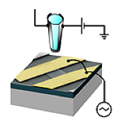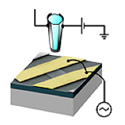Putting the squeeze on bilayer graphene
Bilayer graphene consists of two graphene sheets stacked on top of each other. In this form of graphene, the presence of collective many-body effects leads to new physics—different from that of single-layer graphene or other two-dimensional electron gas systems.
Theory predicts several phases with broken symmetry for bilayer graphene at zero magnetic field, including spontaneous charge transfer between layers, nematic ordering, ferroelectric domains, and an anomalous quantum Hall state. Not all of these phases are consistent with bilayer graphene having an energy gap at zero magnetic field, so showing the gap exists would rule out some of the possibilities.
Writing in Physical Review Letters, Jens Martin and colleagues at Harvard University probe the charge carriers in a suspended flake of bilayer graphene with a scanning single-electron transistor. They measure the electric incompressibility of the graphene, defined as the change in chemical potential with charge carrier density. From this, they find that the quantum Hall energy gaps do not vanish at zero field, but instead merge into an incompressible region near the charge neutrality point, indicating the presence of an ordered state. Martin et al.’s measurements narrow down the possible description of graphene to either an anomalous quantum Hall state or a nematic phase, though further studies will be needed to choose between the two. – Daniel Ucko





